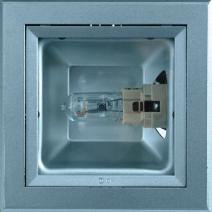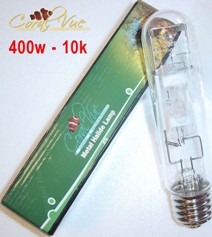Categories: Featured Articles » Sources of light
Number of views: 20239
Comments on the article: 2
Metal halide lamps: area of emitting metals
 The article is devoted to metal halide lamps, the features of their design, operation and application.
The article is devoted to metal halide lamps, the features of their design, operation and application.
Meeting the term "Metal halide lamp", most have associations with an incandescent lamp, its halogen cycle variety. Now this is the most common misconception. Especially when, after the protests of chemists, they changed the already established name “metal halide” to “metal halide”. Without going into linguistic disputes, we agree that we will talk about one of the representatives of discharge lamps.
This representative is rather capricious, expensive and dangerous. Nevertheless, for more than four decades, such light sources have been produced in a wide assortment by leading lighting companies. The annual production of metal halide lamps by OSRAM alone is more than 10 million units. If we add the products of General Electric and Philips to this amount, it will become clear that such lamps are in significant demand.
What is remarkable for this type of lamp if the consumer puts up with the high price and complexity of operation? The answer is simple: when using metal halide lamps, a color image is transmitted with minimal distortion, or, as lighting technicians say, lamps have a high color rendering index.
 Watching television programs, we do not think about how many tricks are required to make the picture on the color screen look natural. The human eye has different sensitivity to different parts of the spectrum. The photodetectors of television cameras have their nonlinear spectral sensitivity. If you add another light source with poor color rendering, then video engineers in the studios can go crazy. After all, even now all people are made up without fail to obtain a natural skin color.
Watching television programs, we do not think about how many tricks are required to make the picture on the color screen look natural. The human eye has different sensitivity to different parts of the spectrum. The photodetectors of television cameras have their nonlinear spectral sensitivity. If you add another light source with poor color rendering, then video engineers in the studios can go crazy. After all, even now all people are made up without fail to obtain a natural skin color.
The ability to emit light in the visible region, which is close in spectrum to the sun, ensured the indispensability of metal halide lamps. The design of such lamps is similar to conventional lamps of the type DRL (mercury fluorescent) or sodium (in the case of ceramic burners). But the radiation mechanisms are somewhat more complicated.
Before moving on to the features of the work, we briefly consider the design features metal halide lamps (MGL).  The heart of the lamp is a discharge chamber, which is made of optical quartz glass or ceramic. In the case of ceramics, polycor is used. Polycor is a polycrystalline alumina ceramic that is resistant to high temperatures and aggressive alkali metals.
The heart of the lamp is a discharge chamber, which is made of optical quartz glass or ceramic. In the case of ceramics, polycor is used. Polycor is a polycrystalline alumina ceramic that is resistant to high temperatures and aggressive alkali metals.
The discharge chamber (burner) is placed in an external flask made of tungsten glass, which allows maximum coordination of the temperature coefficient of expansion of the material of the current inputs with TCR glass. The shape of the outer bulbs is as diverse as the types of lamp caps. As a rule, the geometry of the flasks is dictated by the design of the luminaire in which the MGL will be operated. Flasks of an elliptical shape and cylindrical, the so-called spotlight design, are common.
Switching schemes are typical for discharge lamps. But for MGL, in addition to electromagnetic or electronic ballasts, an arsonist device is also required. Attempts to realize an ignition circuit in a MGL with a quartz burner using auxiliary electrodes failed. After the initial technological annealing of the burners, the additives filling it condensed in the extra electrode space and the ignition circuit was shunted. Therefore, the MGL switching circuit is similar to that for sodium lamps.
In the instruction manual for these sources of light often a requirement is given for the orientation of lamps with a quartz burner with the spout of the solder plug up. Typically, this requirement applies to lamps for use in particularly demanding conditions and with two sockets. Sockets with threaded types E27 and E40 are not able to provide this orientation.
The meaning of this requirement is that the plug (the tube through which the burners are pumped out and dosed) after desoldering protrudes above the surface and has a lower temperature than the main surface of the quartz burner. Even such a slight violation of the geometry can affect the processes in the discharge and change the color parameters of the lamps.
 In the manufacture of the burner, in addition to mercury and argon, a tablet consisting of a mixture of three metal iodides is dosed. Compounds of indium, thallium, and sodium, with bright emission lines in the blue, green, and yellow spectral regions, result in warm white light.
In the manufacture of the burner, in addition to mercury and argon, a tablet consisting of a mixture of three metal iodides is dosed. Compounds of indium, thallium, and sodium, with bright emission lines in the blue, green, and yellow spectral regions, result in warm white light.
But only under one condition: the temperature of the coldest point of the burner must be strictly determined during the service life to ensure the partial pressure of each component in the discharge.
This temperature (and the main electrical parameters of the discharge arc) is determined by the amount of mercury that is dosed into the burner. Arc discharge occurs in unsaturated mercury vapor (all mercury evaporates) and saturated vapor of emitting impurities. Under such conditions, the smallest deviation in the geometry of the burners or the amount of mercury causes a change in the temperature of the cold zone of the burner. The concentration of each metal in the discharge and, accordingly, the spectrum of the lamp are disturbed.
A high color rendering index of a metal halide lamp is the result of the balance “on the knife blade”: as soon as the mutual ratio of each component is broken, the lamp becomes unsuitable for further use in critical applications. Lighting up roads or production areas with such lamps is expensive.
 In what areas can not do without metal halide lamps? First of all, this is studio lighting, printing and textile industry. If we consider the full range of applications, then this is window dressing, lighting of art galleries and museums. The upper limit of capacities is floodlight systems. They are used for architectural lighting of buildings and structures, stadiums, lighting career development. The lamp power ranges from 20 to 18000 W, the supply voltage is 220 and 380 V.
In what areas can not do without metal halide lamps? First of all, this is studio lighting, printing and textile industry. If we consider the full range of applications, then this is window dressing, lighting of art galleries and museums. The upper limit of capacities is floodlight systems. They are used for architectural lighting of buildings and structures, stadiums, lighting career development. The lamp power ranges from 20 to 18000 W, the supply voltage is 220 and 380 V.
It would be interesting to use metal halide lamps in car headlights. The ability to correct the spectrum from warm white to yellow compares them favorably with the xenon discharge with its cool white color. But the obstacle is a fairly long time to reach the operating mode of the lamps. The “booster time” is determined by the warm-up period of the cold point of the burner and ranges from several to ten minutes, depending on the lamp power.
Concluding the story about this type of lamp, I want to make a warning. MGL lamps were not used for domestic lighting due to the complexity of power circuits. But there is another reason why they should never be used in the domestic sector. The composition of burners, in addition to mercury, includes a compound of thallium, the toxicity of which significantly exceeds mercury. Thallium and its compounds are the strongest poison that affects the nervous system, kidneys, etc.
Therefore, you need to be extremely careful in cases where an unfamiliar type of lamp falls into your hands. Due to the prevalence of MGF, this possibility is great, and the consequences can be sad.
See also at bgv.electricianexp.com
:
